Evaluating Australian Climate Policies for 2030 Target Achievement
VerifiedAdded on 2020/10/23
|6
|1215
|174
Report
AI Summary
This report investigates the effectiveness of Australian policies in achieving the 2030 climate change target. The research begins with an introduction outlining the significance of climate change in Australia and the need for effective policies. It details the aim to identify the effectiveness of these policies, along with specific objectives. The methodology includes a positivism research philosophy, with data collection involving both primary and secondary sources, including surveys of environmental specialists. The report discusses data analysis methods, ethical considerations such as privacy and bias, and acknowledges limitations. The study reviews existing literature and uses qualitative and quantitative research methods to analyze and interpret data, ultimately aiming to provide recommendations for improving climate change control in Australia. References to books, journals, and online resources are included to support the findings and analysis.
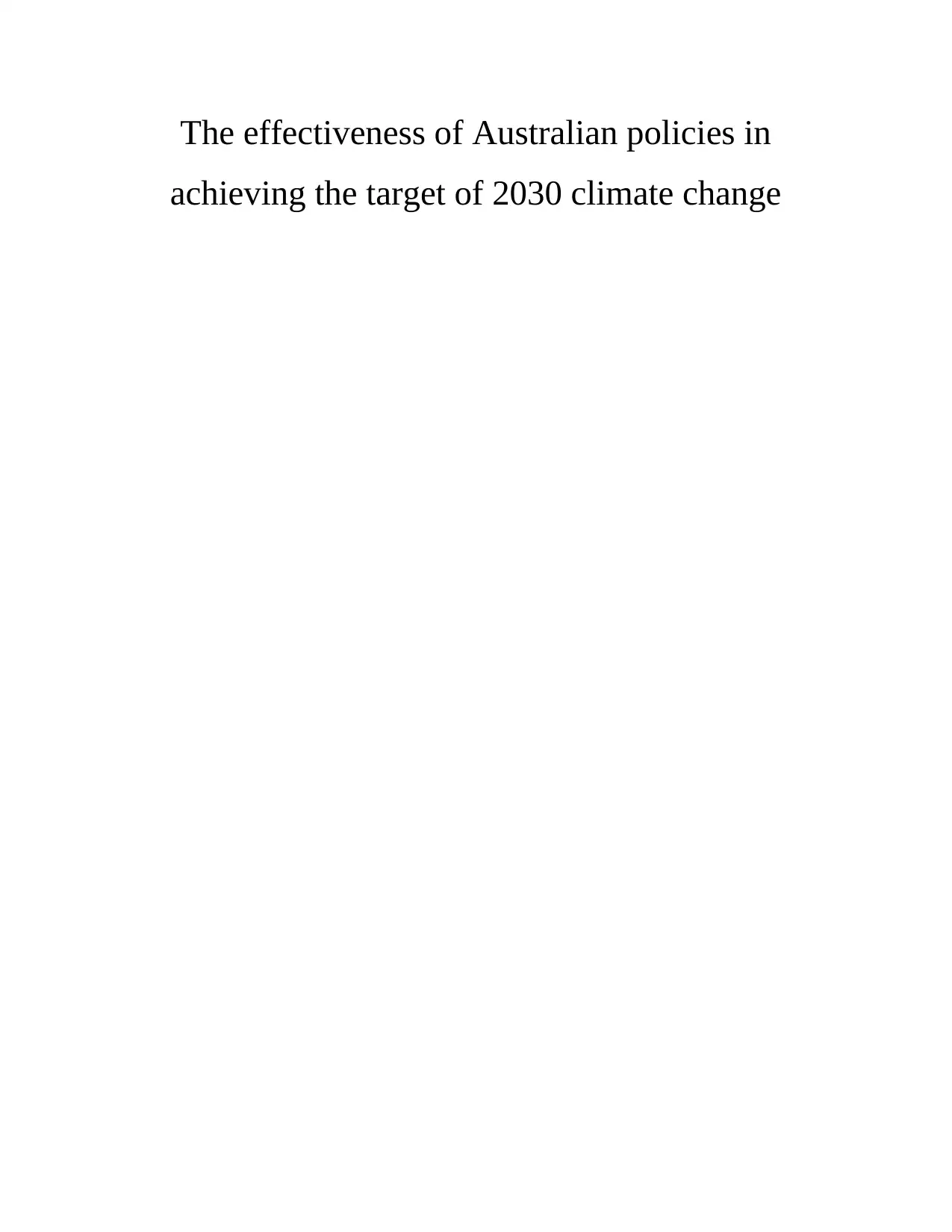
The effectiveness of Australian policies in
achieving the target of 2030 climate change
achieving the target of 2030 climate change
Paraphrase This Document
Need a fresh take? Get an instant paraphrase of this document with our AI Paraphraser
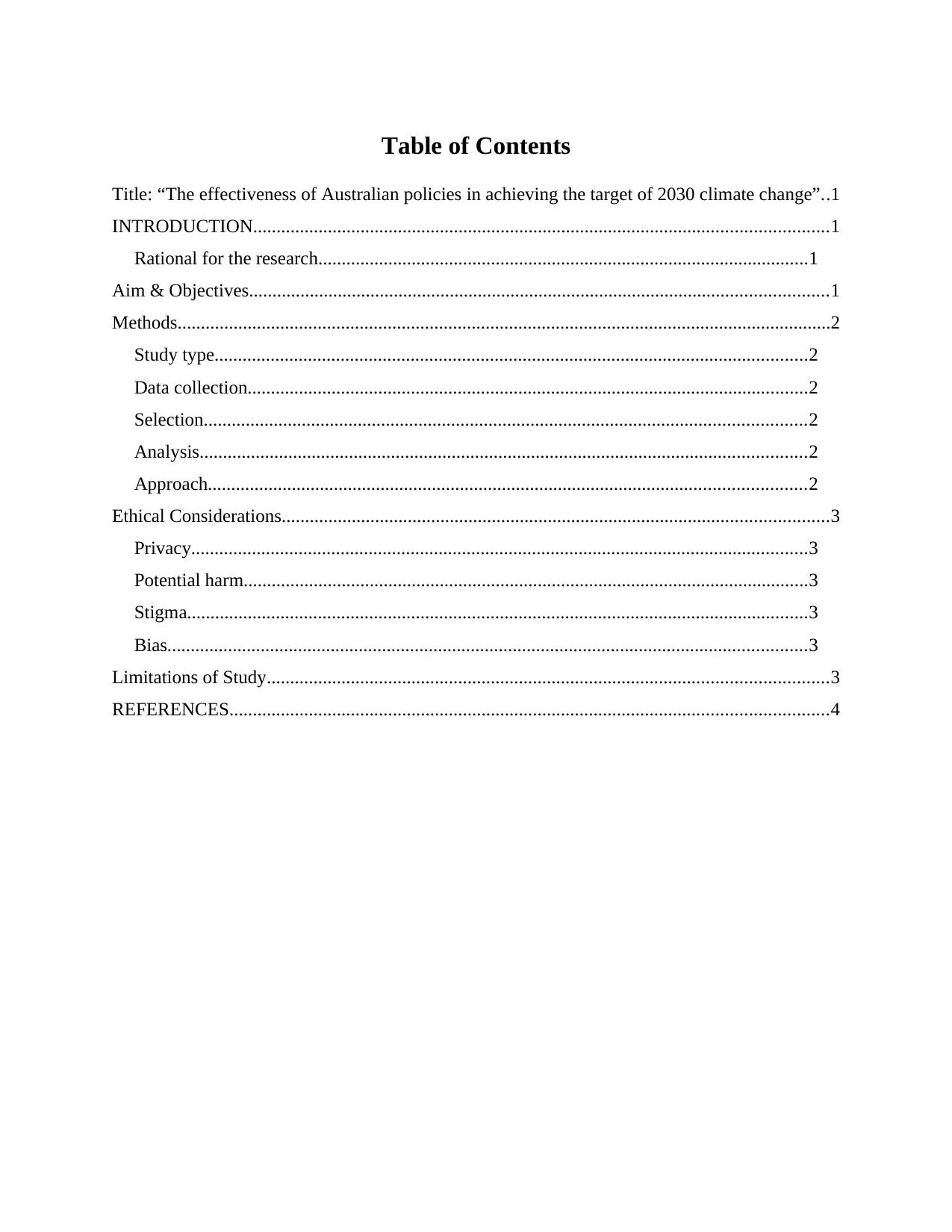
Table of Contents
Title: “The effectiveness of Australian policies in achieving the target of 2030 climate change”..1
INTRODUCTION...........................................................................................................................1
Rational for the research.........................................................................................................1
Aim & Objectives............................................................................................................................1
Methods............................................................................................................................................2
Study type...............................................................................................................................2
Data collection........................................................................................................................2
Selection.................................................................................................................................2
Analysis..................................................................................................................................2
Approach................................................................................................................................2
Ethical Considerations.....................................................................................................................3
Privacy....................................................................................................................................3
Potential harm.........................................................................................................................3
Stigma.....................................................................................................................................3
Bias.........................................................................................................................................3
Limitations of Study........................................................................................................................3
REFERENCES................................................................................................................................4
Title: “The effectiveness of Australian policies in achieving the target of 2030 climate change”..1
INTRODUCTION...........................................................................................................................1
Rational for the research.........................................................................................................1
Aim & Objectives............................................................................................................................1
Methods............................................................................................................................................2
Study type...............................................................................................................................2
Data collection........................................................................................................................2
Selection.................................................................................................................................2
Analysis..................................................................................................................................2
Approach................................................................................................................................2
Ethical Considerations.....................................................................................................................3
Privacy....................................................................................................................................3
Potential harm.........................................................................................................................3
Stigma.....................................................................................................................................3
Bias.........................................................................................................................................3
Limitations of Study........................................................................................................................3
REFERENCES................................................................................................................................4
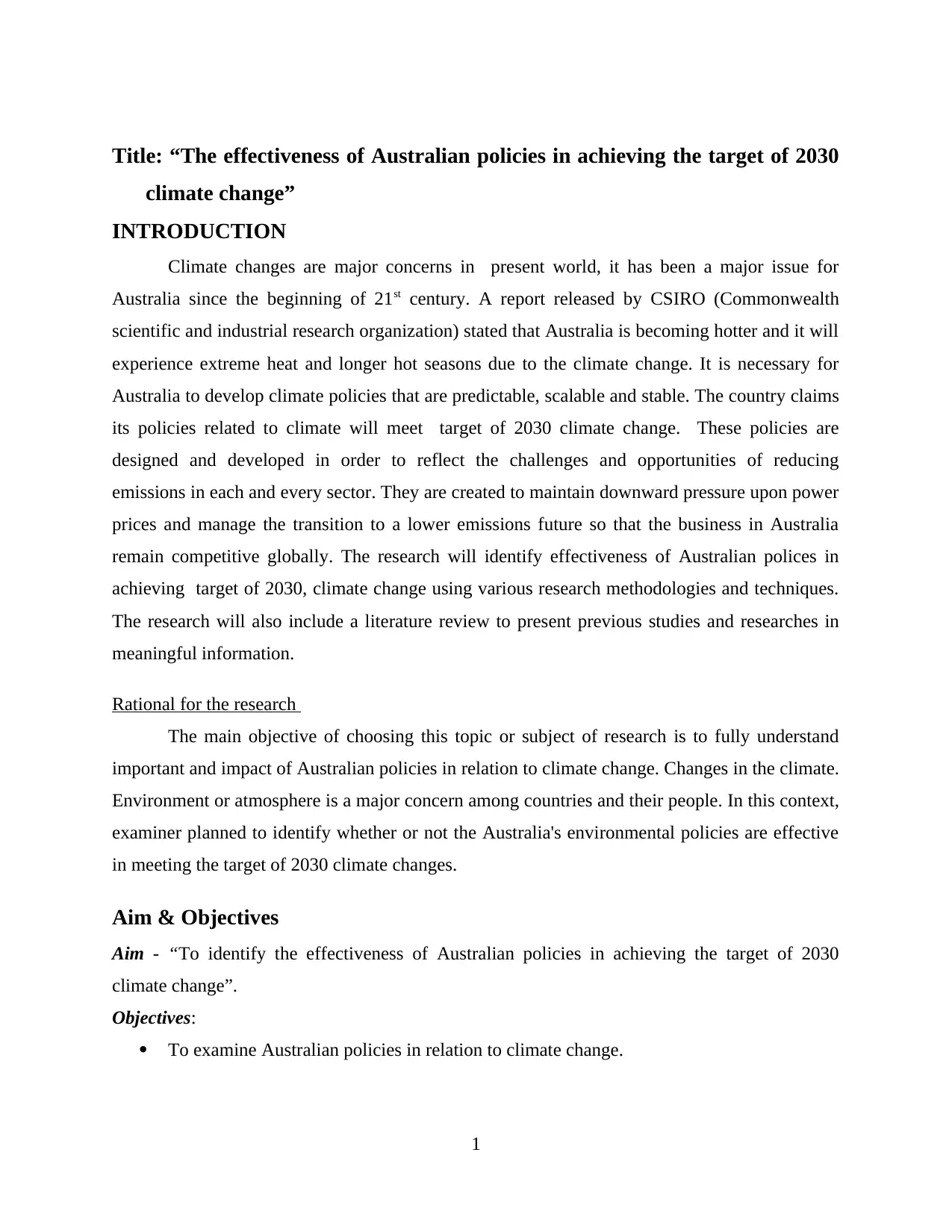
Title: “The effectiveness of Australian policies in achieving the target of 2030
climate change”
INTRODUCTION
Climate changes are major concerns in present world, it has been a major issue for
Australia since the beginning of 21st century. A report released by CSIRO (Commonwealth
scientific and industrial research organization) stated that Australia is becoming hotter and it will
experience extreme heat and longer hot seasons due to the climate change. It is necessary for
Australia to develop climate policies that are predictable, scalable and stable. The country claims
its policies related to climate will meet target of 2030 climate change. These policies are
designed and developed in order to reflect the challenges and opportunities of reducing
emissions in each and every sector. They are created to maintain downward pressure upon power
prices and manage the transition to a lower emissions future so that the business in Australia
remain competitive globally. The research will identify effectiveness of Australian polices in
achieving target of 2030, climate change using various research methodologies and techniques.
The research will also include a literature review to present previous studies and researches in
meaningful information.
Rational for the research
The main objective of choosing this topic or subject of research is to fully understand
important and impact of Australian policies in relation to climate change. Changes in the climate.
Environment or atmosphere is a major concern among countries and their people. In this context,
examiner planned to identify whether or not the Australia's environmental policies are effective
in meeting the target of 2030 climate changes.
Aim & Objectives
Aim - “To identify the effectiveness of Australian policies in achieving the target of 2030
climate change”.
Objectives:
To examine Australian policies in relation to climate change.
1
climate change”
INTRODUCTION
Climate changes are major concerns in present world, it has been a major issue for
Australia since the beginning of 21st century. A report released by CSIRO (Commonwealth
scientific and industrial research organization) stated that Australia is becoming hotter and it will
experience extreme heat and longer hot seasons due to the climate change. It is necessary for
Australia to develop climate policies that are predictable, scalable and stable. The country claims
its policies related to climate will meet target of 2030 climate change. These policies are
designed and developed in order to reflect the challenges and opportunities of reducing
emissions in each and every sector. They are created to maintain downward pressure upon power
prices and manage the transition to a lower emissions future so that the business in Australia
remain competitive globally. The research will identify effectiveness of Australian polices in
achieving target of 2030, climate change using various research methodologies and techniques.
The research will also include a literature review to present previous studies and researches in
meaningful information.
Rational for the research
The main objective of choosing this topic or subject of research is to fully understand
important and impact of Australian policies in relation to climate change. Changes in the climate.
Environment or atmosphere is a major concern among countries and their people. In this context,
examiner planned to identify whether or not the Australia's environmental policies are effective
in meeting the target of 2030 climate changes.
Aim & Objectives
Aim - “To identify the effectiveness of Australian policies in achieving the target of 2030
climate change”.
Objectives:
To examine Australian policies in relation to climate change.
1
⊘ This is a preview!⊘
Do you want full access?
Subscribe today to unlock all pages.

Trusted by 1+ million students worldwide
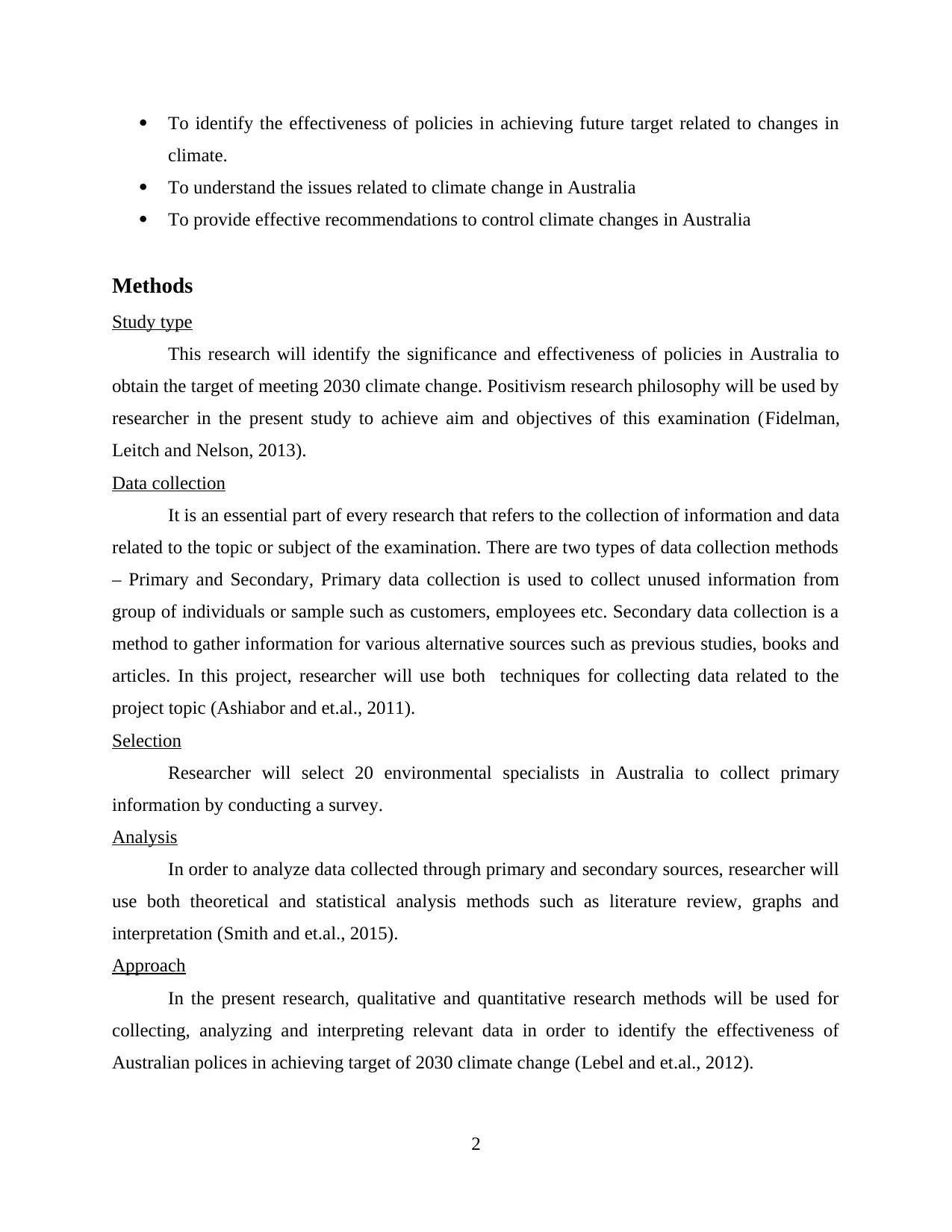
To identify the effectiveness of policies in achieving future target related to changes in
climate.
To understand the issues related to climate change in Australia
To provide effective recommendations to control climate changes in Australia
Methods
Study type
This research will identify the significance and effectiveness of policies in Australia to
obtain the target of meeting 2030 climate change. Positivism research philosophy will be used by
researcher in the present study to achieve aim and objectives of this examination (Fidelman,
Leitch and Nelson, 2013).
Data collection
It is an essential part of every research that refers to the collection of information and data
related to the topic or subject of the examination. There are two types of data collection methods
– Primary and Secondary, Primary data collection is used to collect unused information from
group of individuals or sample such as customers, employees etc. Secondary data collection is a
method to gather information for various alternative sources such as previous studies, books and
articles. In this project, researcher will use both techniques for collecting data related to the
project topic (Ashiabor and et.al., 2011).
Selection
Researcher will select 20 environmental specialists in Australia to collect primary
information by conducting a survey.
Analysis
In order to analyze data collected through primary and secondary sources, researcher will
use both theoretical and statistical analysis methods such as literature review, graphs and
interpretation (Smith and et.al., 2015).
Approach
In the present research, qualitative and quantitative research methods will be used for
collecting, analyzing and interpreting relevant data in order to identify the effectiveness of
Australian polices in achieving target of 2030 climate change (Lebel and et.al., 2012).
2
climate.
To understand the issues related to climate change in Australia
To provide effective recommendations to control climate changes in Australia
Methods
Study type
This research will identify the significance and effectiveness of policies in Australia to
obtain the target of meeting 2030 climate change. Positivism research philosophy will be used by
researcher in the present study to achieve aim and objectives of this examination (Fidelman,
Leitch and Nelson, 2013).
Data collection
It is an essential part of every research that refers to the collection of information and data
related to the topic or subject of the examination. There are two types of data collection methods
– Primary and Secondary, Primary data collection is used to collect unused information from
group of individuals or sample such as customers, employees etc. Secondary data collection is a
method to gather information for various alternative sources such as previous studies, books and
articles. In this project, researcher will use both techniques for collecting data related to the
project topic (Ashiabor and et.al., 2011).
Selection
Researcher will select 20 environmental specialists in Australia to collect primary
information by conducting a survey.
Analysis
In order to analyze data collected through primary and secondary sources, researcher will
use both theoretical and statistical analysis methods such as literature review, graphs and
interpretation (Smith and et.al., 2015).
Approach
In the present research, qualitative and quantitative research methods will be used for
collecting, analyzing and interpreting relevant data in order to identify the effectiveness of
Australian polices in achieving target of 2030 climate change (Lebel and et.al., 2012).
2
Paraphrase This Document
Need a fresh take? Get an instant paraphrase of this document with our AI Paraphraser
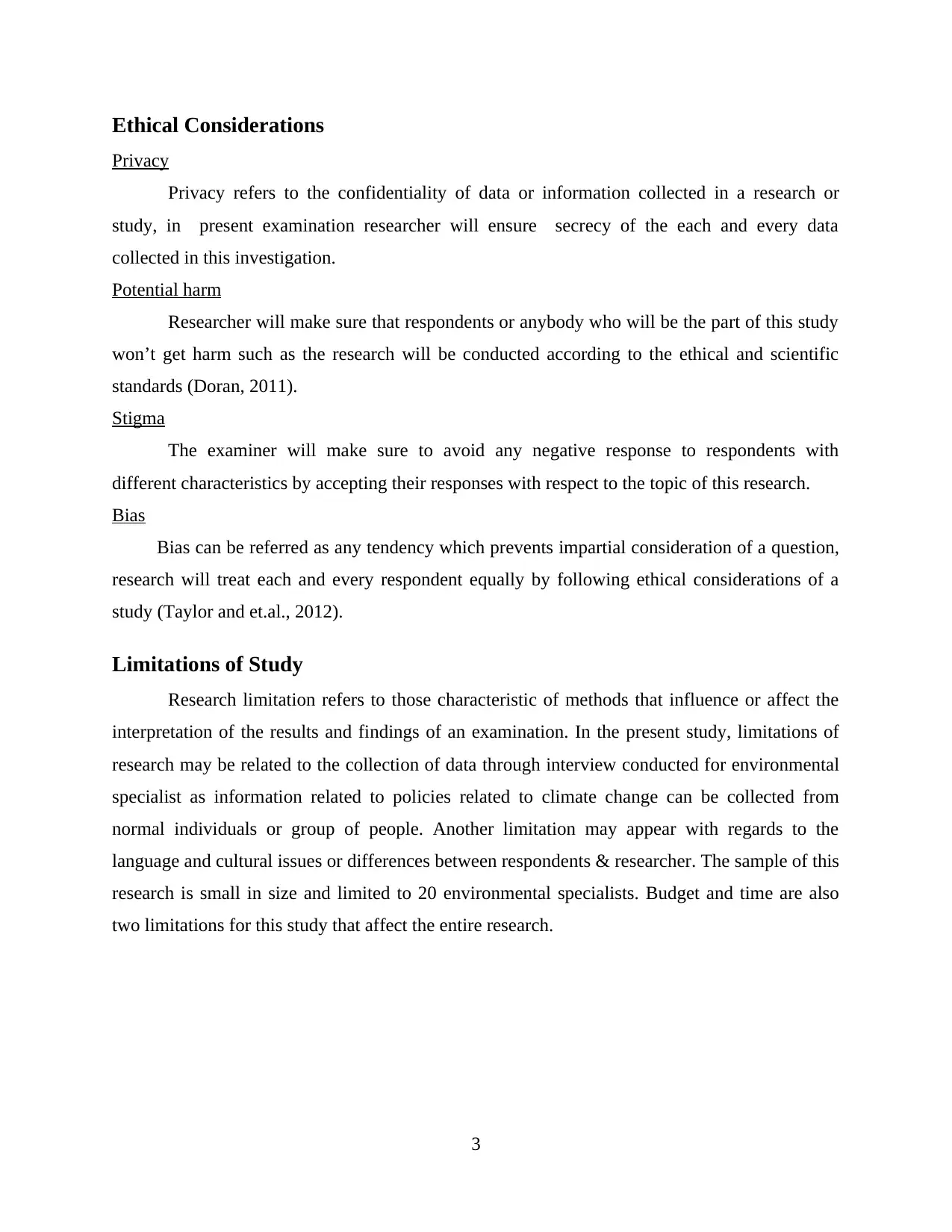
Ethical Considerations
Privacy
Privacy refers to the confidentiality of data or information collected in a research or
study, in present examination researcher will ensure secrecy of the each and every data
collected in this investigation.
Potential harm
Researcher will make sure that respondents or anybody who will be the part of this study
won’t get harm such as the research will be conducted according to the ethical and scientific
standards (Doran, 2011).
Stigma
The examiner will make sure to avoid any negative response to respondents with
different characteristics by accepting their responses with respect to the topic of this research.
Bias
Bias can be referred as any tendency which prevents impartial consideration of a question,
research will treat each and every respondent equally by following ethical considerations of a
study (Taylor and et.al., 2012).
Limitations of Study
Research limitation refers to those characteristic of methods that influence or affect the
interpretation of the results and findings of an examination. In the present study, limitations of
research may be related to the collection of data through interview conducted for environmental
specialist as information related to policies related to climate change can be collected from
normal individuals or group of people. Another limitation may appear with regards to the
language and cultural issues or differences between respondents & researcher. The sample of this
research is small in size and limited to 20 environmental specialists. Budget and time are also
two limitations for this study that affect the entire research.
3
Privacy
Privacy refers to the confidentiality of data or information collected in a research or
study, in present examination researcher will ensure secrecy of the each and every data
collected in this investigation.
Potential harm
Researcher will make sure that respondents or anybody who will be the part of this study
won’t get harm such as the research will be conducted according to the ethical and scientific
standards (Doran, 2011).
Stigma
The examiner will make sure to avoid any negative response to respondents with
different characteristics by accepting their responses with respect to the topic of this research.
Bias
Bias can be referred as any tendency which prevents impartial consideration of a question,
research will treat each and every respondent equally by following ethical considerations of a
study (Taylor and et.al., 2012).
Limitations of Study
Research limitation refers to those characteristic of methods that influence or affect the
interpretation of the results and findings of an examination. In the present study, limitations of
research may be related to the collection of data through interview conducted for environmental
specialist as information related to policies related to climate change can be collected from
normal individuals or group of people. Another limitation may appear with regards to the
language and cultural issues or differences between respondents & researcher. The sample of this
research is small in size and limited to 20 environmental specialists. Budget and time are also
two limitations for this study that affect the entire research.
3
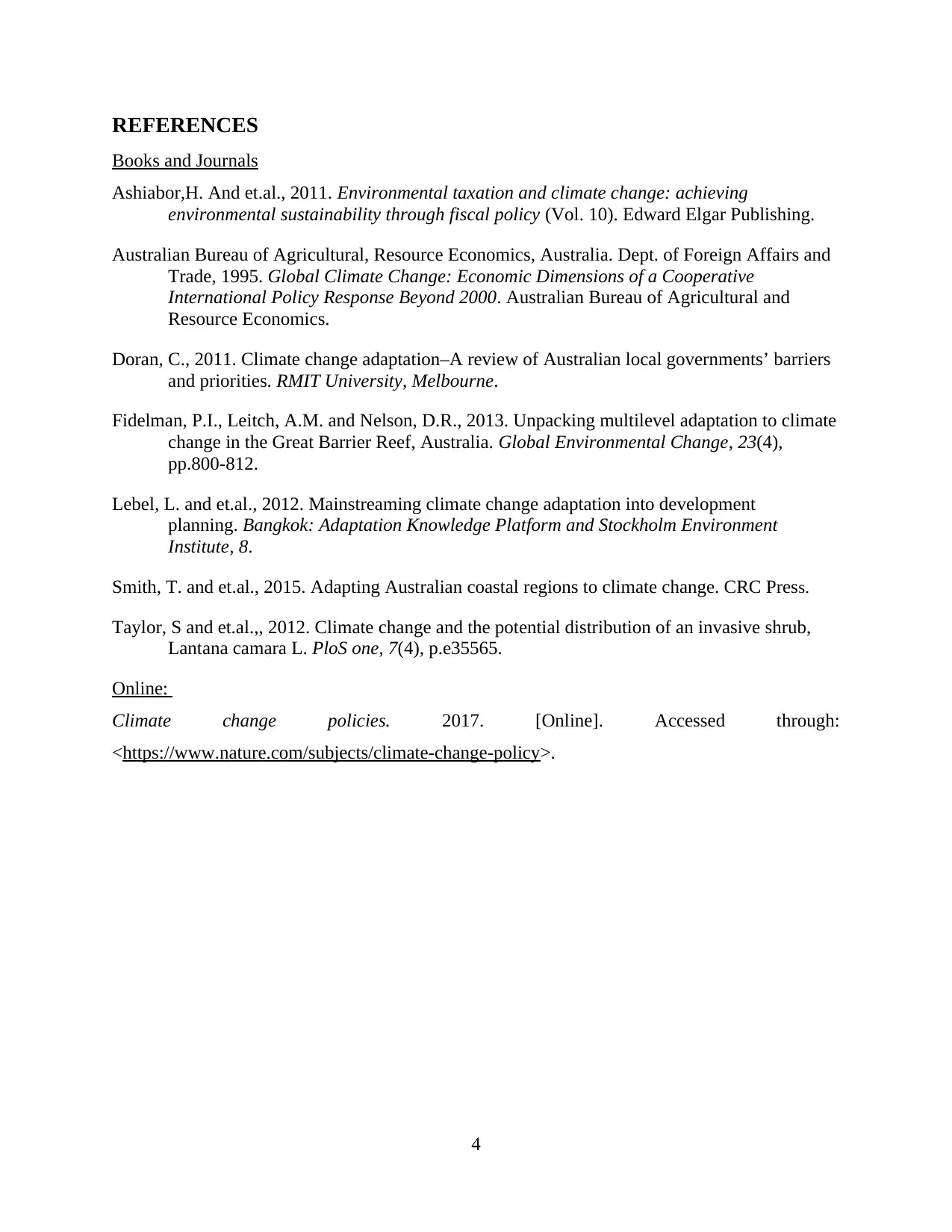
REFERENCES
Books and Journals
Ashiabor,H. And et.al., 2011. Environmental taxation and climate change: achieving
environmental sustainability through fiscal policy (Vol. 10). Edward Elgar Publishing.
Australian Bureau of Agricultural, Resource Economics, Australia. Dept. of Foreign Affairs and
Trade, 1995. Global Climate Change: Economic Dimensions of a Cooperative
International Policy Response Beyond 2000. Australian Bureau of Agricultural and
Resource Economics.
Doran, C., 2011. Climate change adaptation–A review of Australian local governments’ barriers
and priorities. RMIT University, Melbourne.
Fidelman, P.I., Leitch, A.M. and Nelson, D.R., 2013. Unpacking multilevel adaptation to climate
change in the Great Barrier Reef, Australia. Global Environmental Change, 23(4),
pp.800-812.
Lebel, L. and et.al., 2012. Mainstreaming climate change adaptation into development
planning. Bangkok: Adaptation Knowledge Platform and Stockholm Environment
Institute, 8.
Smith, T. and et.al., 2015. Adapting Australian coastal regions to climate change. CRC Press.
Taylor, S and et.al.,, 2012. Climate change and the potential distribution of an invasive shrub,
Lantana camara L. PloS one, 7(4), p.e35565.
Online:
Climate change policies. 2017. [Online]. Accessed through:
<https://www.nature.com/subjects/climate-change-policy>.
4
Books and Journals
Ashiabor,H. And et.al., 2011. Environmental taxation and climate change: achieving
environmental sustainability through fiscal policy (Vol. 10). Edward Elgar Publishing.
Australian Bureau of Agricultural, Resource Economics, Australia. Dept. of Foreign Affairs and
Trade, 1995. Global Climate Change: Economic Dimensions of a Cooperative
International Policy Response Beyond 2000. Australian Bureau of Agricultural and
Resource Economics.
Doran, C., 2011. Climate change adaptation–A review of Australian local governments’ barriers
and priorities. RMIT University, Melbourne.
Fidelman, P.I., Leitch, A.M. and Nelson, D.R., 2013. Unpacking multilevel adaptation to climate
change in the Great Barrier Reef, Australia. Global Environmental Change, 23(4),
pp.800-812.
Lebel, L. and et.al., 2012. Mainstreaming climate change adaptation into development
planning. Bangkok: Adaptation Knowledge Platform and Stockholm Environment
Institute, 8.
Smith, T. and et.al., 2015. Adapting Australian coastal regions to climate change. CRC Press.
Taylor, S and et.al.,, 2012. Climate change and the potential distribution of an invasive shrub,
Lantana camara L. PloS one, 7(4), p.e35565.
Online:
Climate change policies. 2017. [Online]. Accessed through:
<https://www.nature.com/subjects/climate-change-policy>.
4
⊘ This is a preview!⊘
Do you want full access?
Subscribe today to unlock all pages.

Trusted by 1+ million students worldwide
1 out of 6
Related Documents
Your All-in-One AI-Powered Toolkit for Academic Success.
+13062052269
info@desklib.com
Available 24*7 on WhatsApp / Email
![[object Object]](/_next/static/media/star-bottom.7253800d.svg)
Unlock your academic potential
Copyright © 2020–2025 A2Z Services. All Rights Reserved. Developed and managed by ZUCOL.





